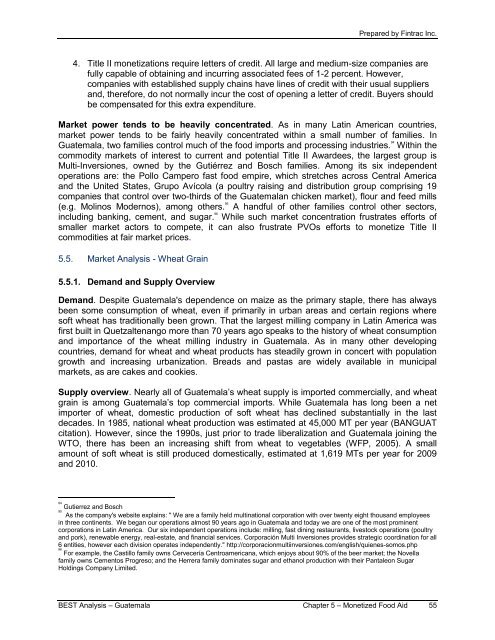usaid office of food for peace guatemala bellmon estimation
usaid office of food for peace guatemala bellmon estimation
usaid office of food for peace guatemala bellmon estimation
Create successful ePaper yourself
Turn your PDF publications into a flip-book with our unique Google optimized e-Paper software.
Prepared by Fintrac Inc.<br />
4. Title II monetizations require letters <strong>of</strong> credit. All large and medium-size companies are<br />
fully capable <strong>of</strong> obtaining and incurring associated fees <strong>of</strong> 1-2 percent. However,<br />
companies with established supply chains have lines <strong>of</strong> credit with their usual suppliers<br />
and, there<strong>for</strong>e, do not normally incur the cost <strong>of</strong> opening a letter <strong>of</strong> credit. Buyers should<br />
be compensated <strong>for</strong> this extra expenditure.<br />
Market power tends to be heavily concentrated. As in many Latin American countries,<br />
market power tends to be fairly heavily concentrated within a small number <strong>of</strong> families. In<br />
Guatemala, two families control much <strong>of</strong> the <strong>food</strong> imports and processing industries. 94<br />
Within the<br />
commodity markets <strong>of</strong> interest to current and potential Title II Awardees, the largest group is<br />
Multi-Inversiones, owned by the Gutiérrez and Bosch families. Among its six independent<br />
operations are: the Pollo Campero fast <strong>food</strong> empire, which stretches across Central America<br />
and the United States, Grupo Avícola (a poultry raising and distribution group comprising 19<br />
companies that control over two-thirds <strong>of</strong> the Guatemalan chicken market), flour and feed mills<br />
(e.g. Molinos Modernos), among others. 95<br />
A handful <strong>of</strong> other families control other sectors,<br />
including banking, cement, and sugar. 96<br />
While such market concentration frustrates ef<strong>for</strong>ts <strong>of</strong><br />
smaller market actors to compete, it can also frustrate PVOs ef<strong>for</strong>ts to monetize Title II<br />
commodities at fair market prices.<br />
5.5. Market Analysis - Wheat Grain<br />
5.5.1. Demand and Supply Overview<br />
Demand. Despite Guatemala's dependence on maize as the primary staple, there has always<br />
been some consumption <strong>of</strong> wheat, even if primarily in urban areas and certain regions where<br />
s<strong>of</strong>t wheat has traditionally been grown. That the largest milling company in Latin America was<br />
first built in Quetzaltenango more than 70 years ago speaks to the history <strong>of</strong> wheat consumption<br />
and importance <strong>of</strong> the wheat milling industry in Guatemala. As in many other developing<br />
countries, demand <strong>for</strong> wheat and wheat products has steadily grown in concert with population<br />
growth and increasing urbanization. Breads and pastas are widely available in municipal<br />
markets, as are cakes and cookies.<br />
Supply overview. Nearly all <strong>of</strong> Guatemala’s wheat supply is imported commercially, and wheat<br />
grain is among Guatemala’s top commercial imports. While Guatemala has long been a net<br />
importer <strong>of</strong> wheat, domestic production <strong>of</strong> s<strong>of</strong>t wheat has declined substantially in the last<br />
decades. In 1985, national wheat production was estimated at 45,000 MT per year (BANGUAT<br />
citation). However, since the 1990s, just prior to trade liberalization and Guatemala joining the<br />
WTO, there has been an increasing shift from wheat to vegetables (WFP, 2005). A small<br />
amount <strong>of</strong> s<strong>of</strong>t wheat is still produced domestically, estimated at 1,619 MTs per year <strong>for</strong> 2009<br />
and 2010.<br />
94<br />
Gutierrez and Bosch<br />
95<br />
As the company's website explains: " We are a family held multinational corporation with over twenty eight thousand employees<br />
in three continents. We began our operations almost 90 years ago in Guatemala and today we are one <strong>of</strong> the most prominent<br />
corporations in Latin America. Our six independent operations include: milling, fast dining restaurants, livestock operations (poultry<br />
and pork), renewable energy, real-estate, and financial services. Corporación Multi Inversiones provides strategic coordination <strong>for</strong> all<br />
6 entities, however each division operates independently." http://corporacionmultiinversiones.com/english/quienes-somos.php<br />
96<br />
For example, the Castillo family owns Cervecería Centroamericana, which enjoys about 90% <strong>of</strong> the beer market; the Novella<br />
family owns Cementos Progreso; and the Herrera family dominates sugar and ethanol production with their Pantaleon Sugar<br />
Holdings Company Limited.<br />
BEST Analysis – Guatemala Chapter 5 – Monetized Food Aid 55

















